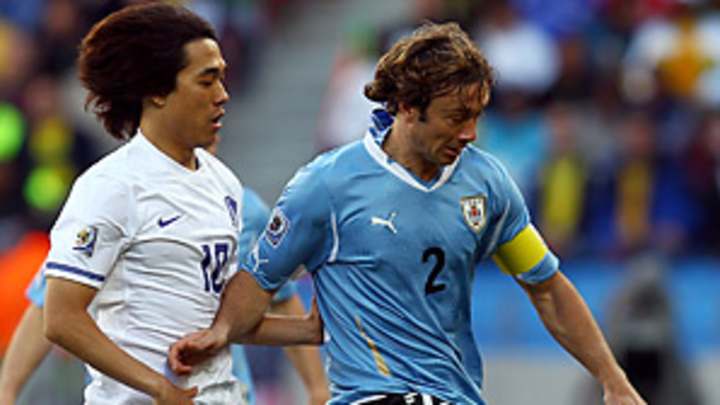Uruguay looks to relive glory days

During Uruguay home games over the last decade or so, a giant banner has been unfurled in the crowd in Montevideo's Centenario stadium. On it is a number -- 1950.
The banner commemorates the last time that La Celeste (the Sky Blues) won the World Cup. It is a tribute to the skill of that team from 60 years ago, to names such as Juan Schiaffino, Alcides Ghiggia and Oscar Miguez, all legends of the Uruguayan game.
But in addition to their skill, the banner is also a tribute to the temperament of that team, exemplified by captain Obdulia Varela. Uruguay had to go into the lion's den in order to win the 1950 World Cup . It had to beat one of the all-time great Brazil sides in Rio de Janeiro's newly built Maracana stadium, in front of a crowd that in all probability was not far short of 200,000. Brazil had won its previous games 7-1 and 6-1, and needed only a draw to be champions. It took the lead against Uruguay, which refused to wilt and struck back to win 2-1.
On Friday, Uruguay is back in the lion's den. When it meets Ghana in the quarterfinals, it will be taking on much more than a country. In Africa's first World Cup, Ghana now represents the honor of the entire continent. There have even been reports of millions of Nigerians swallowing their pride to cheer on Ghana's Black Stars. There will be a powerful wind blowing behind the Ghana players in Johannesburg.
And Uruguay would not have it any other way. This is the type of situation that so often brings out the best in the Sky Blues -- and not just in 1950. On a lesser scale, the current team has a track record of spoiling the party. In 2007, it produced a clinical display to eliminate host Venezuela from the Copa America.
Uruguay, then, feels that it has the temperament and ability to cope with the Ghana game. The team has a spine of experienced players, all of whom are enjoying an excellent campaign. There is captain and center back Diego Lugano (though he might struggle on Friday against the pace of Asamoah Gyan), tigerish midfielder Diego Perez and Diego Forlan up front, a genuine class act with his reading of the game, and the pace, thrust and quality that he brings to the attack.
Alongside these veterans, there is also an interesting generation of younger players breaking through. For a country with a population little greater than 3 million, Uruguay produces footballers in extraordinary quantity. Over the last few years priority has been given to developing technically gifted youngsters, and the hard work is bearing fruit.
In the mid-'90s, Jose Pekerman took over as Argentina's youth specialist with a discourse that was ahead of its time. The globalization of the game is a fact, he argued, and we will therefore lose our promising youngsters to European clubs at an ever younger age. We must, therefore, use the youth structures to secure them for the long-term use of the senior national team. Indeed, Argentina's youth development work took on the aspect of a university, giving the players a crash course in the footballing identity of the country and churning out a succession of talented players for the senior national side -- players who might play their club football in Europe, but, especially when brought together with their compatriots, retained a specifically Argentine flavor.
Uruguay has gone down the same path, with coach Oscar Washington Tabarez overseeing a project that encompasses the national teams at all levels. Indeed, with its much smaller population, its need is still greater. The limitations of the domestic market make it unavoidable that the brightest talents move abroad early. The youth sides, then, are where players are prepared for the long haul in the Uruguay shirt.
Last year, Uruguay performed well and showcased promising players in the World Cups at both U-17 and U-20 levels. The latter side looked especially interesting. In the course of the campaign they drew 2-2 with eventual champions Ghana, who have fast tracked several members of that team into the senior squad in action in South Africa. Uruguay has so far promoted only one, captain of that side Nicolas Lodeiro, who was on target in the game against Ghana. The little left-footed playmaker appears to have recovered from receiving the first red card of the tournament, and will be an interesting option on the bench.
Lodeiro, though, is a player for the future. Luis Suarez is a player for the present. A graduate of the 2007 U-20 team, Suarez gives the team its cutting edge, as he showed with the two goals that overcame South Korea in the previous round.
With his stocky build and low center of gravity, Suarez loves cutting in toward goal from wide positions. He can be inconsistent and frustrating, but this is part of his threat. With his pace and ability to go either side of the defender, it is difficult to predict what he will do. He has so many options available to him that he does not always choose the best one -- but when he does he can dismantle any defense.
If Forlan and Suarez can hit form together, then along with its resilience Uruguay can count on the fire and skill to get past Ghana. If it does, then maybe in a few year's time there will be another banner in the crowd whenever Uruguay plays in the Centenario stadium -- with "2010" written on it.
